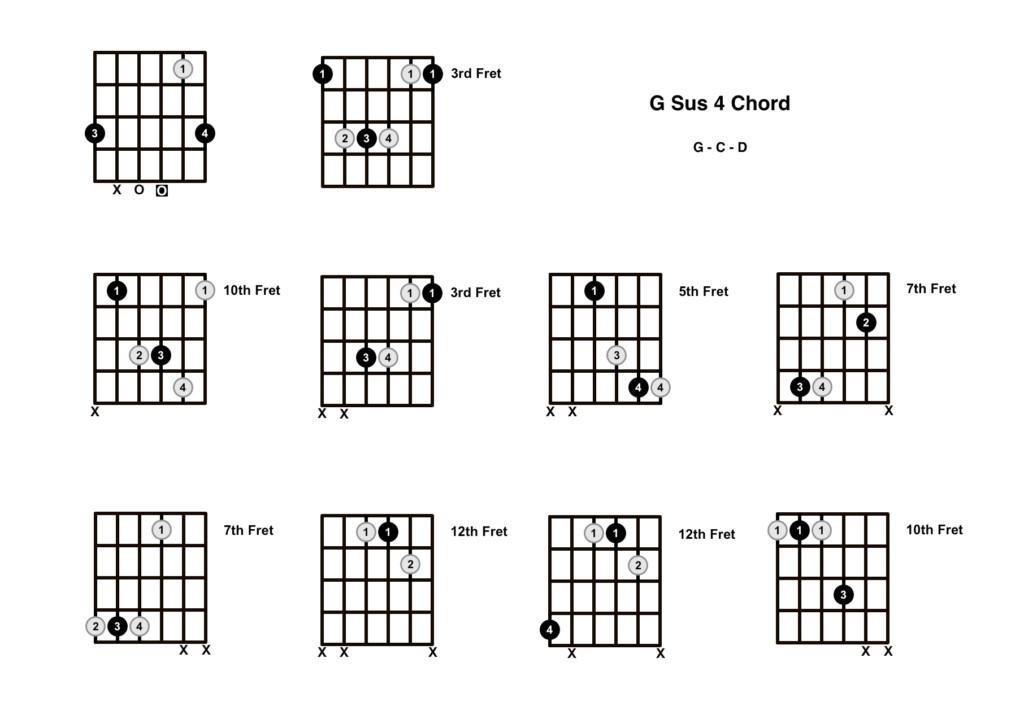The G Sus Guitar Chord, often written as Gsus4, is a fascinating and versatile chord that adds a unique flavor to your guitar playing. It’s neither major nor minor, offering a suspended sound that creates musical tension and release. Understanding and utilizing the G sus chord can significantly enrich your chord vocabulary and musical expression.
What is a Suspended Chord?
Before diving specifically into the G sus 4, let’s briefly explore what “suspended” chords mean in music theory. Suspended chords, often abbreviated as “sus,” replace the third of a major or minor chord with either a second (sus2) or a fourth (sus4) interval. This substitution creates a characteristic “suspended” or unresolved sound because the third is crucial in defining a chord as major or minor.
In the case of a sus4 chord, like our G sus 4, the third is replaced by the fourth. This 4th interval creates a feeling of musical tension, often resolving beautifully when it moves to the major chord, where the natural major third is restored. Think of it as a musical question that finds its answer in the resolution.
Deconstructing the G Sus 4 Chord
The G suspended 4 chord is built from the notes G, C, and D. To understand how these notes form the chord, we can look at the G Major scale: G, A, B, C, D, E, F#.
The G sus 4 chord utilizes the:
- 1st degree (root): G
- 4th degree: C
- 5th degree: D
Noticeably absent is the 3rd degree (B) of the G Major scale. This is the key to the “suspended” quality. By replacing the major third (B) with the perfect fourth (C), we lose the definitive major tonality and introduce that suspended, open sound. Essentially, the G sus 4 chord can be thought of as a G Major chord where the B note is temporarily “suspended” and replaced by a C.
This substitution creates a noticeable musical effect. The 4th (C) creates a tension that feels like it wants to resolve. This resolution is typically achieved by moving to a G Major chord, reinstating the B note and resolving the suspended tension.
To really hear this in action, try playing this simple chord progression:
G Major – G sus 4 – G Major
Strum each chord for a few counts. You’ll immediately hear the slight tension introduced by the G sus 4 and the satisfying resolution when you return to the G Major. This push and pull is what makes the sus chord so musically interesting.
Playing the G Sus 4 Chord: Shapes and Positions
The G sus 4 chord is a relatively easy chord to play on the guitar, especially in its open position. This is often the first shape guitarists learn.
Here are several ways to play the G sus 4 chord, catering to different positions on the guitar neck:
 G Sus 4 Chord 10 Shapes
G Sus 4 Chord 10 Shapes
The image above showcases 10 different shapes for the G sus 4 chord. However, the most common and beginner-friendly way to play it is in the open position. This open G sus 4 chord shape is very similar to the open G Major chord, with a slight modification of just one finger.
Experiment with these different shapes to find what sounds best in different musical contexts and positions on the fretboard. Understanding various voicings of the G sus 4 will give you more flexibility in your playing.
Using the G Sus 4 Chord in Your Music
The G sus 4 chord is frequently used as a subtle variation and embellishment of the G Major chord. It’s a great way to add a touch of musical movement and interest without drastically changing the harmonic landscape.
Here are some common ways to incorporate the G sus 4 into your playing:
- Chord Progressions: As demonstrated earlier, the G – Gsus4 – G progression is a classic example of using the sus chord for tension and release. You can integrate this movement into various songs and musical styles.
- Substitution: Try substituting a G sus 4 chord momentarily in place of a G Major chord within a song. This creates a brief lift and a slightly different harmonic color, adding subtle dynamism to your chord progressions.
- Intros and Outros: G sus 4 chords can be effective in introductions and outros of songs, creating a sense of anticipation or lingering resonance.
- Genre Versatility: While commonly found in pop and rock music, sus chords are versatile and can be used across genres like folk, country, and even jazz to add harmonic interest.
By experimenting with the G sus 4 chord in different musical contexts, you’ll discover its unique sonic qualities and how it can enhance your guitar playing.
Conclusion
The G sus 4 guitar chord is a valuable addition to any guitarist’s toolkit. It’s a simple yet effective chord that offers a unique suspended sound, creating musical tension and resolution. By understanding its construction, exploring different shapes, and experimenting with its use in chord progressions, you can unlock the musical potential of the G sus 4 and add depth and interest to your guitar playing. Start incorporating it into your practice and compositions to experience the subtle yet powerful impact of this versatile chord.
